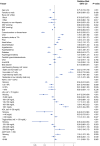Lipoprotein (a) Testing in Patients With Atherosclerotic Cardiovascular Disease in 5 Large US Health Systems
- PMID: 39494552
- PMCID: PMC11935684
- DOI: 10.1161/JAHA.124.035610
Lipoprotein (a) Testing in Patients With Atherosclerotic Cardiovascular Disease in 5 Large US Health Systems
Abstract
Background: Lipoprotein (a) is an independent risk factor for atherosclerotic cardiovascular disease. However, lipoprotein (a) testing remains variable and it is unclear what factors influence testing and if testing changes clinical management.
Methods and results: A retrospective study using electronic medical record data from 5 health systems identified an atherosclerotic cardiovascular disease cohort divided into those with and without a lipoprotein (a) test between 2019 and 2021. Baseline characteristics and lipid-lowering therapy patterns were assessed. Multivariable regression modeling was used to determine factors associated with lipoprotein (a) testing. Among 595 684 patients with atherosclerotic cardiovascular disease, only 2587 (0.4%) were tested for lipoprotein (a). Those who were older or Black individuals were less likely to have lipoprotein (a) testing, while those with familial hypercholesterolemia, ischemic stroke/transient ischemic attack, peripheral artery disease, prior lipid-lowering therapy, or low-density lipoprotein cholesterol ≥130 mg/dL were more likely to be tested. Those with a lipoprotein (a) test, regardless of the lipoprotein (a) value, were more frequently initiated on any statin therapy (30.3% versus 10.6%, P < 0.001), ezetimibe (7.65% versus 0.8%, P < 0.001), or proprotein convertase substilisin/kexin type 9 inhibitor (6.7% versus 0.3%, P < 0.001) compared with those without a test. Those with an elevated lipoprotein (a) level more frequently initiated ezetimibe (11.5% versus 5.9%, P < 0.001) or proprotein convertase substilisin/kexin type 9 inhibitor (10.9% versus 4.8%, P < 0.001).
Conclusions: Lipoprotein (a) testing in patients with atherosclerotic cardiovascular disease is infrequent, with evidence of disparities among older or Black individuals. Testing for lipoprotein (a), regardless of level, is associated with greater initiation of any lipid-lowering therapy, while elevated lipoprotein (a) is associated with greater initiation of nonstatin lipid-lowering therapy. There is a critical need for multidisciplinary and inclusive approaches to raise awareness for lipoprotein (a) testing, and its implications on management.
Keywords: ASCVD; lipids; lipoprotein (a).
Figures



References
-
- Virani SS, Alonso A, Benjamin EJ, Bittencourt MS, Callaway CW, Carson AP, Chamberlain AM, Chang AR, Cheng S, Delling FN, et al. Heart disease and stroke statistics—2020 update a report from the American Heart Association. Circulation. 2020;141:e139–e596. doi: 10.1161/CIR.0000000000000757 - DOI - PubMed
-
- Grundy SM, Stone NJ, Bailey AL, Beam C, Birtcher KK, Blumenthal RS, Braun LT, de Ferranti S, Faiella‐Tommasino J, Forman DE, et al. AHA/ACC/AACVPR/AAPA/ABC/ACPM/ADA/AGS/APhA/ASPC/NLA/PCNA guideline on the management of blood cholesterol: executive summary: a report of the American College of Cardiology/American Heart Association Task Force on Clinical Practice Guidelines. Circulation. 2018;2019:139. doi: 10.1161/CIR.0000000000000624 - DOI - PubMed
-
- Mach F, Baigent C, Catapano AL, Koskinas KC, Casula M, Badimon L, Chapman MJ, de Backer GG, Delgado V, Ference BA, et al. 2019 ESC/EAS guidelines for the management of dyslipidaemias: lipid modification to reduce cardiovascular risk. Eur Heart J. 2020;41:111–188. doi: 10.1093/eurheartj/ehz455 - DOI - PubMed
Publication types
MeSH terms
Substances
LinkOut - more resources
Full Text Sources
Medical
Miscellaneous

